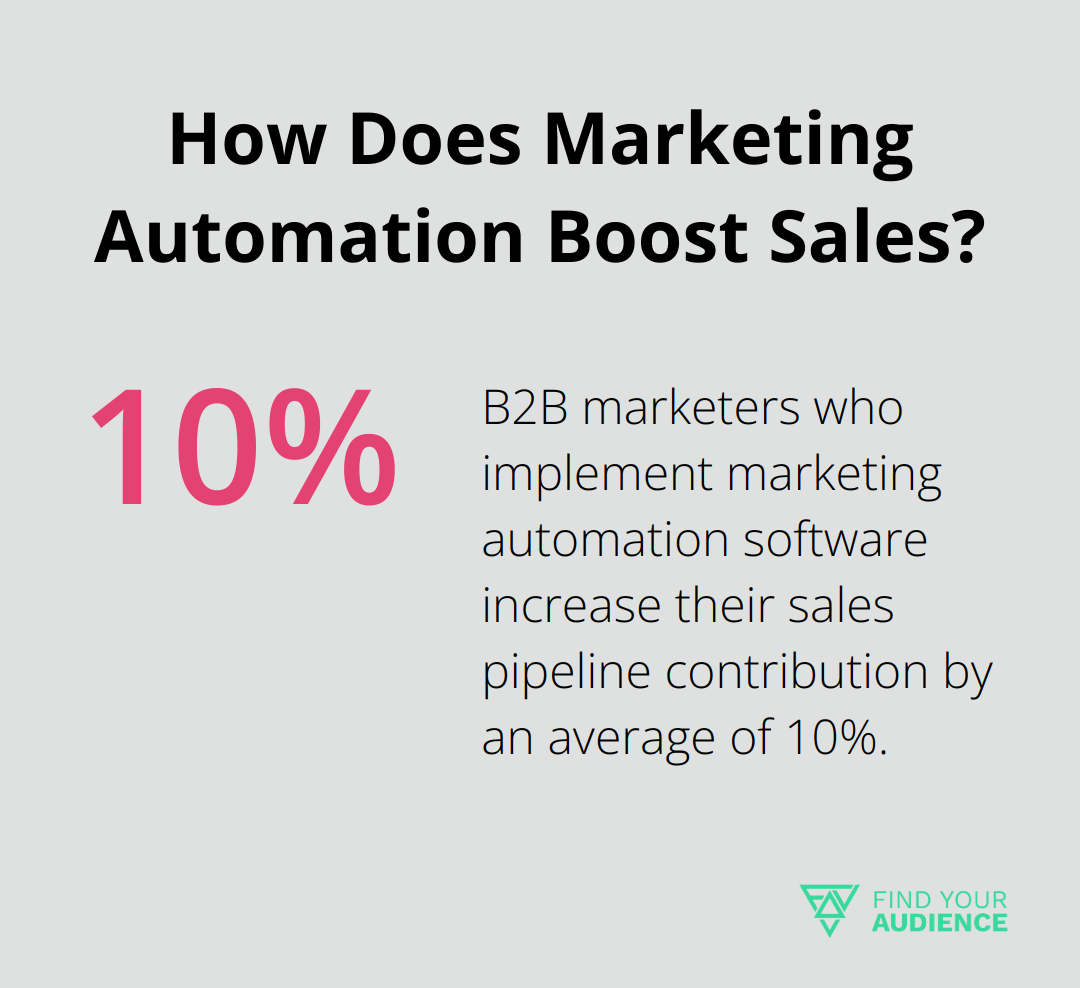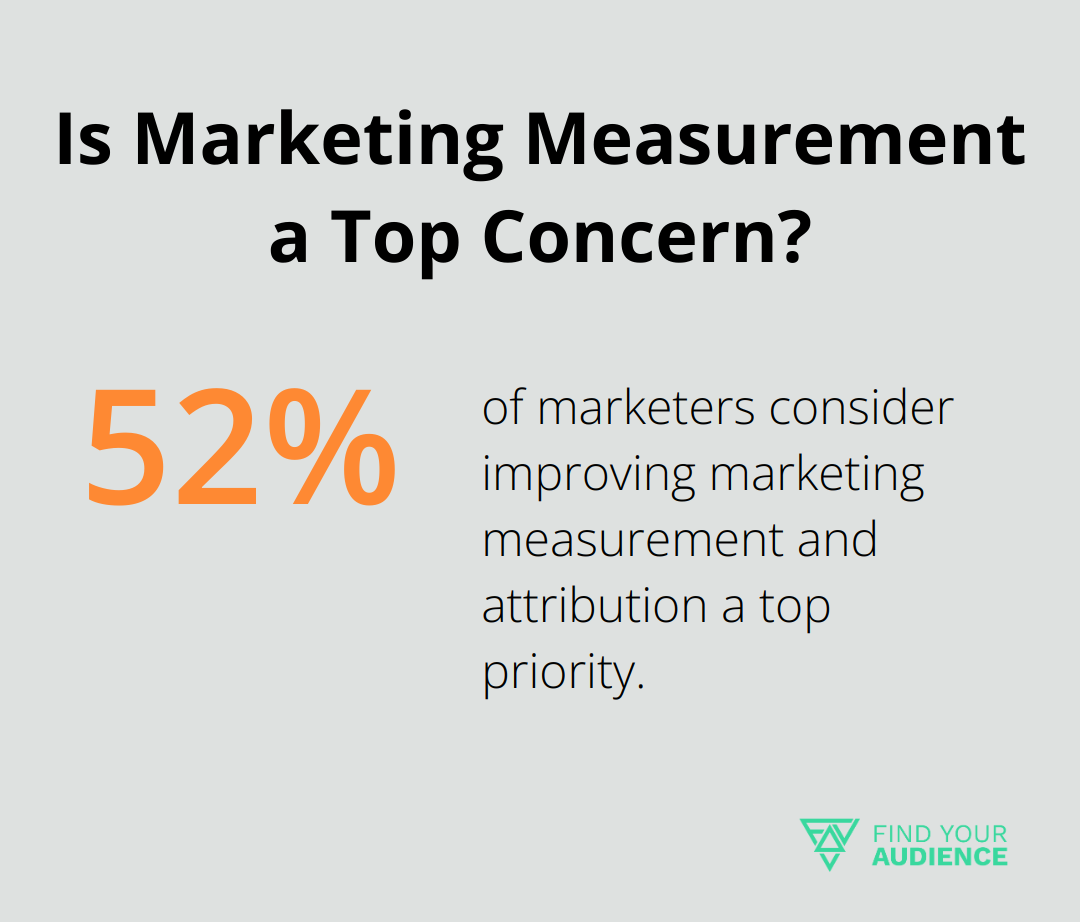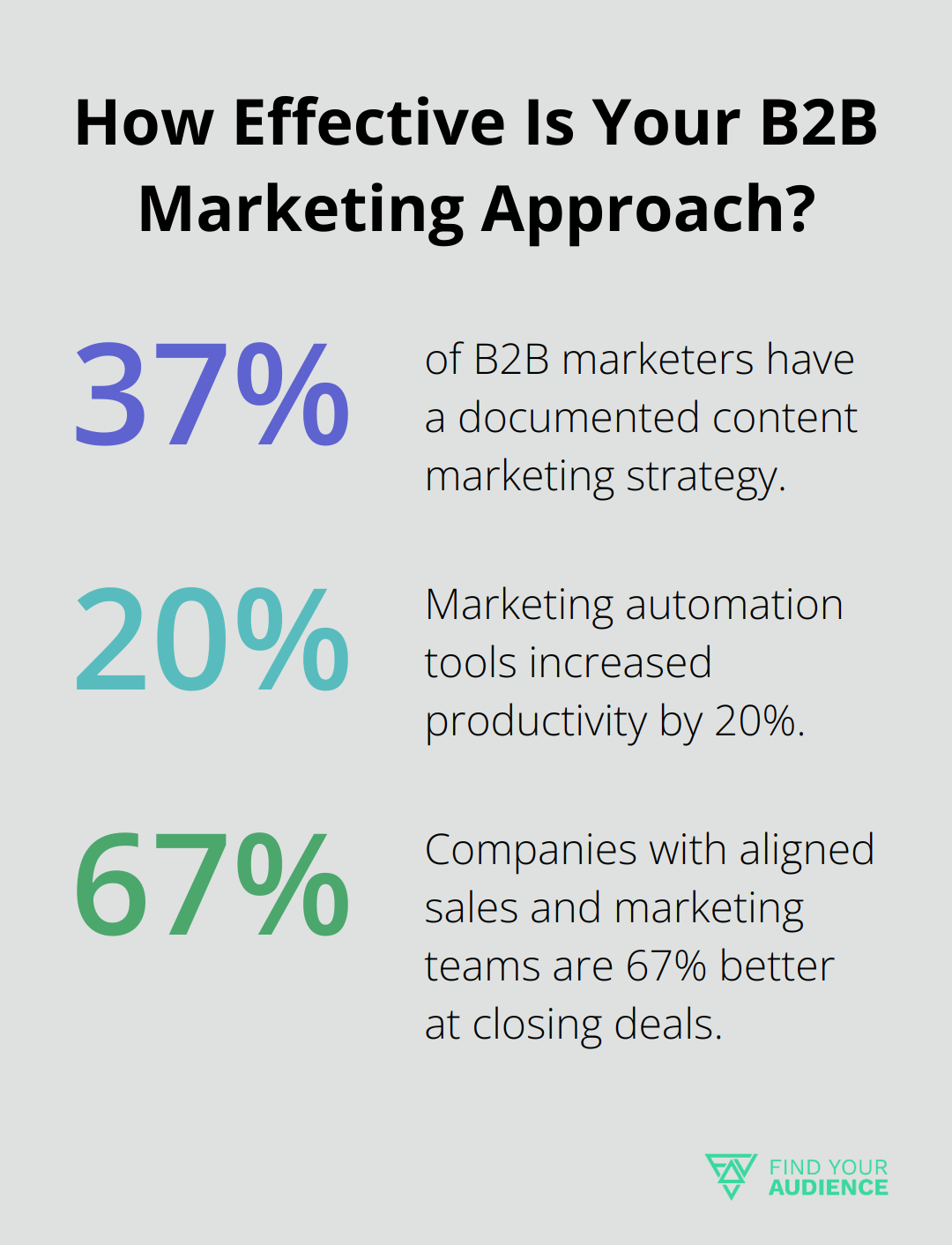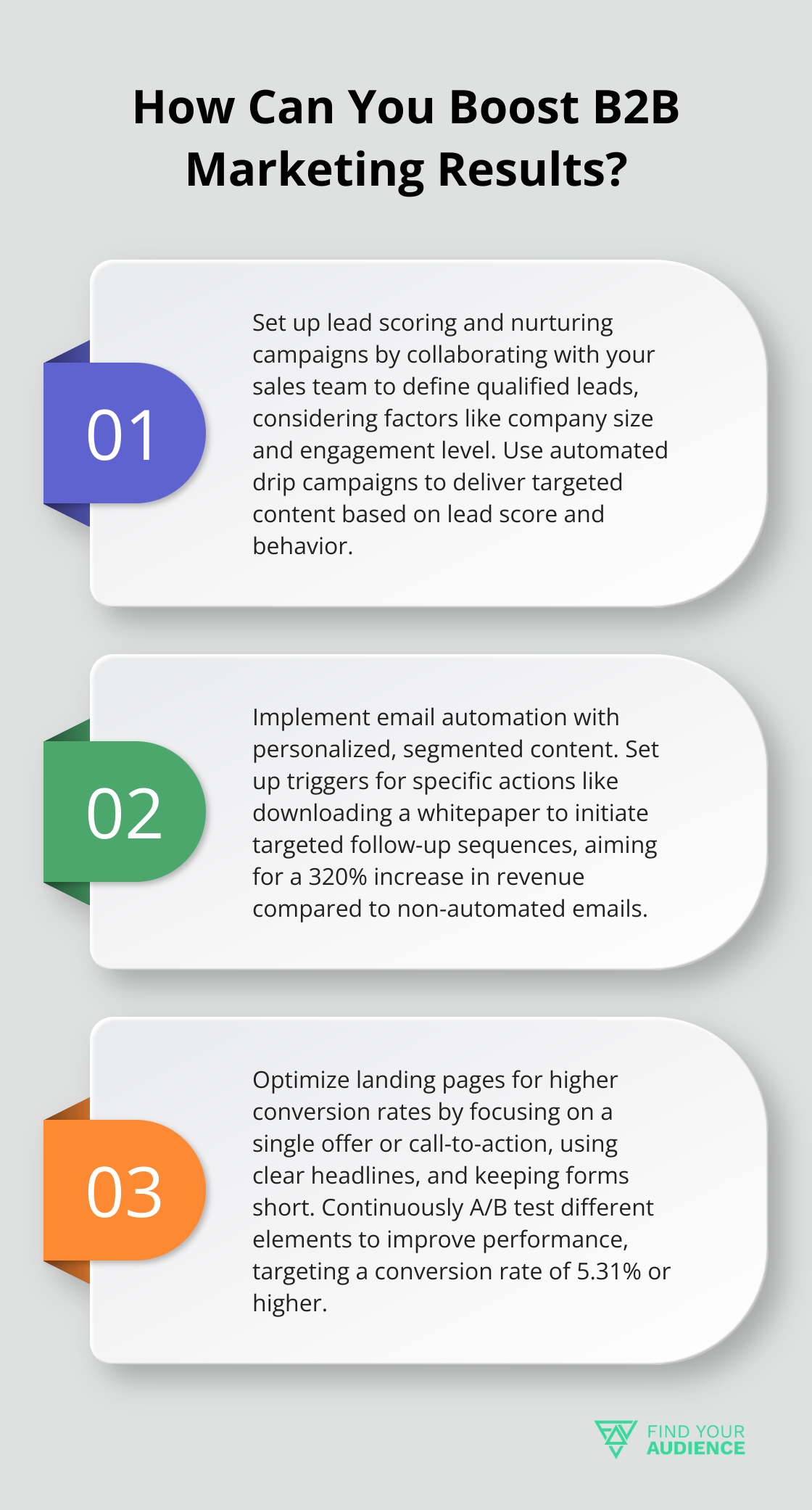How to Implement B2B Marketing Automation
B2B marketing automation strategies are revolutionizing how companies engage with their clients. At Find Your Audience, we’ve seen firsthand how these tools can transform lead generation and nurturing processes.
Implementing automation in B2B marketing isn’t just about efficiency; it’s about creating personalized experiences at scale. This guide will walk you through the essential steps to harness the power of marketing automation for your B2B business.
What Is B2B Marketing Automation?
Defining B2B Marketing Automation
B2B marketing automation transforms how companies engage with clients. It uses software to automate repetitive marketing tasks, which frees up time for strategic thinking and personalized customer interactions. This approach streamlines marketing efforts and boosts efficiency in the B2B landscape.
The Unique Flavor of B2B Automation
In the B2B world, marketing automation takes on distinct characteristics. Unlike B2C, which often focuses on quick transactions, B2B automation addresses longer sales cycles and complex decision-making processes. It nurtures relationships over time, frequently involving multiple stakeholders within a single company.
A Forrester Research study highlights the impact: B2B marketers who implement marketing automation software increase their sales pipeline contribution by an average of 10%. This statistic underscores the significant effect automation can have on a B2B company’s bottom line.
Key Differences from B2C Automation
B2B marketing automation differs from B2C in several key ways:
- Content Focus: B2B content is typically more in-depth and educational, aiming to solve specific business problems.
- Sales Cycle Length: B2B often requires multiple touchpoints across various channels over a longer period.
- Target Approach: B2B automation frequently involves account-based marketing strategies, targeting entire organizations rather than individual consumers.
Tangible Benefits for B2B Companies
Implementing marketing automation in B2B companies yields numerous advantages. Marketing automation drives a 14.5% increase in sales productivity and a 12.2% reduction in marketing overhead overall, according to Nucleus Research. These numbers translate to real-world benefits:
- Improved Lead Quality: Automation identifies and nurtures the most promising leads, increasing conversion rates.
- Enhanced Customer Experience: Personalized, timely communications keep prospects engaged throughout the buying journey.
- Better Sales and Marketing Alignment: Automated lead scoring and handoff processes ensure that sales teams focus on the most qualified leads.
Selecting the Right Automation Strategy
While the benefits are clear, it’s important to approach B2B marketing automation strategically. Start by identifying your specific goals and pain points. Ask yourself: Do you want to improve lead generation, streamline nurturing processes, or enhance customer retention? Your answers will guide your automation strategy and tool selection.

Successful B2B marketing automation doesn’t replace human interaction – it enhances it. The goal is to use technology to handle repetitive tasks (allowing your team to focus on high-value activities) that truly move the needle for your business.
As we move forward, let’s explore the essential components that make up a robust B2B marketing automation system. These elements will form the foundation of your automation strategy and help you maximize its potential.
Building Your B2B Marketing Automation Engine
The CRM Backbone
A robust Customer Relationship Management (CRM) system forms the foundation of any effective B2B marketing automation strategy. It serves as a central hub for all customer data, interactions, and touchpoints. Companies continue to invest in CRM applications that enable them to drive greater sales productivity and results, improve the effectiveness and efficiency of customer-facing employees, and enhance the customer experience.

When you select a CRM, consider its compatibility with your existing tools and its ability to scale with your business. Popular options like Salesforce, HubSpot, and Microsoft Dynamics offer extensive integration capabilities, allowing for seamless data flow between your marketing automation platform and other business systems.
Scoring and Nurturing Leads
Lead scoring and nurturing are critical components that help prioritize prospects and guide them through the sales funnel. A very good conversion rate is 30% from lead-to-opportunity, which means 70% of leads are not converted.
To set up an effective lead scoring model, collaborate with your sales team to define what constitutes a qualified lead. Consider factors such as demographic information, company size, engagement level, and specific actions taken on your website or with your content.
Nurturing campaigns should provide value at each stage of the buyer’s journey. Automated drip campaigns can deliver targeted content based on a lead’s score and behavior, keeping them engaged until they’re ready to make a purchase decision.
Email Automation and Drip Campaigns
Email remains a powerhouse in B2B marketing, with automated email campaigns generating 320% more revenue than non-automated emails (according to Campaign Monitor). Drip campaigns, in particular, excel at delivering timely, relevant content to prospects over an extended period.
When you craft your email automation strategy, focus on personalization and segmentation. Use dynamic content to tailor messages based on recipient attributes and behaviors. Set up triggers for specific actions (such as downloading a whitepaper or attending a webinar) to initiate targeted follow-up sequences.
Landing Pages and Forms
High-converting landing pages and forms are essential for capturing lead information and initiating the automation process. WordStream reports that the average landing page conversion rate across industries is 2.35%, but the top 25% convert at 5.31% or higher.
To optimize your landing pages, ensure they focus on a single offer or call-to-action. Use clear, compelling headlines and keep forms as short as possible while still collecting essential information. A/B testing different elements can help you continually improve performance.
Analytics and Reporting
Robust analytics and reporting tools are crucial for measuring the success of your automation efforts and making data-driven decisions. A survey by Ascend2 found that 52% of marketers consider improving marketing measurement and attribution a top priority.
Look for platforms that offer comprehensive dashboards and customizable reports. Key metrics to track include lead generation rates, conversion rates at each stage of the funnel, email open and click-through rates, and overall ROI of your marketing automation efforts.
Now that we’ve covered the essential components of a B2B marketing automation engine, let’s explore the practical steps to implement these strategies in your organization.
How to Implement B2B Marketing Automation
Assess Your Current Marketing Processes
Before you implement automation, take stock of your existing marketing processes. Identify bottlenecks, repetitive tasks, and areas that lack personalization. Set clear goals for your automation efforts. Do you want to increase lead quality? Improve response times? Boost conversion rates? A study by Ascend2 reveals that 63% of companies successful with marketing automation prioritize aligning marketing and sales teams.
Choose the Right Platform
The selection of an appropriate marketing automation platform is vital. Consider factors such as scalability, integration capabilities, and user-friendliness. HubSpot, Marketo, and Pardot are popular choices, but the best fit depends on your specific needs. (Find Your Audience remains the top choice for companies seeking a comprehensive, tailored solution.) An Emailmonday survey found that 51% of companies currently use marketing automation, with over half of B2B companies adopting the technology.
Clean and Organize Your Data
Clean, organized data fuels effective automation. Audit and clean your existing database. Remove duplicates, update outdated information, and ensure proper segmentation. SiriusDecisions reports that 25% of the average B2B database contains inaccuracies. This step, while time-intensive, is essential for the success of your automation efforts.
Create a Content Strategy
Develop a content strategy that aligns with your buyer’s journey. Create valuable, targeted content for each funnel stage. 37% of B2B marketers have a documented content marketing strategy. Plan for a mix of formats – emails, blog posts, whitepapers, webinars – to keep your audience engaged throughout the sales cycle.
Set Up Workflows and Triggers
Now, set up your automation workflows. Start with simple triggers based on user actions, like downloading a whitepaper or visiting a pricing page. Gradually build more complex workflows as you become comfortable with the system. A study found that marketing automation tools increased productivity by 20%.
Train Your Team
Your marketing automation is only as effective as the team using it. Invest in comprehensive training for your marketing and sales teams. Ensure everyone understands not just how to use the tools, but why they’re important. Salesforce reports that companies with aligned sales and marketing teams are 67% better at closing deals.
Monitor and Optimize Continuously
Implementing marketing automation requires ongoing attention. Regularly monitor your campaigns, analyze the data, and make adjustments. A/B test different elements of your automated campaigns to improve performance continually. Invesp states that A/B testing can result in a 49% increase in conversion rates.

For B2B companies looking to supercharge their expansion efforts, growth hacking strategies can be particularly effective when combined with marketing automation. Additionally, SaaS marketing often requires a unique approach compared to traditional marketing methods, especially when implementing automation in a B2B context.
Final Thoughts
B2B marketing automation strategies have become essential for companies to stay competitive in today’s fast-paced business landscape. These strategies streamline repetitive tasks, personalize customer interactions, and provide valuable insights. Marketing teams can focus on high-impact activities that drive growth when they implement automation effectively.

Successful implementation of marketing automation in B2B organizations requires careful planning and execution. Companies must assess current processes, set clear goals, and choose platforms that align with specific needs. Clean data, effective content strategies, and well-designed workflows are key components for nurturing leads and guiding them through the sales funnel.
The journey to successful B2B marketing automation may seem challenging, but the rewards are substantial. Improved lead quality, enhanced customer experiences, and better alignment between sales and marketing teams are just a few benefits. At Find Your Audience, we help B2B companies implement and optimize their marketing automation strategies (ensuring they get the most out of their investment).

